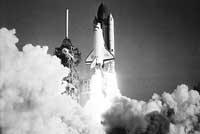40 years of NASA
That same day NASA (National Space and Aeronautics Administration) was born. It did not emerge from nowhere, until then it absorbed NACA (National Advisory Committee for Aeronautics), a pioneer in space problems, with 8,000 workers, a budget of 100 million dollars and its three main research laboratories. Naval Research Laboratory, Jet Propulsion Laboratory and Army Ballistic Missile Agency. Wernher von Braun and his collaborators worked on the design of large rockets.
Wernher von Braun was of German origin. During World War II he worked at the Peemünd base to design the V-1 and V-2 rockets. At the end of the war, both the US and the USSR signed the scientists and engineers of Peemünd to launch their rocket propulsion systems, including von Braun, who then had a great weight in the development of the Apollo program.
It was not an environment in the US, as the Soviets dominated the exploration of space. A year earlier, on October 4, 1957, the Sputnik1 satellite was launched and that event surprised the US completely out of play. Pearl was a kind of Harbour. When a well-known physicist of the time was asked what he expected to reach the Moon, the 'Soviet' replied. NASA was born to deal with this desperation.

The US economic, technological and scientific machine was launched at full speed. Thus, NASA had all the means to develop its work and the concrete challenges: The moonset of man before the end of the 60's. At first they were able to maintain the advantage gained by the Soviet: the first living being in space, the first man in space and the first space march, for example. However, he failed in the big challenge. In fact, through Apollo XI came the first USA to the Moon in 1969.
Success somehow absorbed NASA. In the opinion of many, with the arrival on the Moon NASA had a mission accomplished, defeating the Soviets and, since then, NASA has constantly fought for the proper means. A data may be sufficient: It has a budget of 14 billion dollars in 1991 and 13.5 billion dollars in 1998. Reaching the Moon also meant that every contestant took his way. The Soviets, with the loss of competition for the dazzling of man, undertook especially long-lasting missions and development of space stations. NASA, for its part, soon forgot the Moon, as in 1972 the Apollo ship, number 17, lit up. NASA's practice focused on exploring the Solar System through robotic missions and designing reusable packaging.
The Pioneer or Voyager probes are hatchlings of the first route, which have revolutionized the vision of our planetary system by exploring the giant outer planets. Columbia and its class space ferries are vessels designed for repeated use. They have not been as cheap and effective as they expected, despite the security ghost caused by the Challenger accident, and NASA's strategic option in this field has been paid in the field of conventional launchers. At present, ESA (European Space Agency) and Russia dominate both reliability and mass space in conventional launchers or rockets.
The 1990s has brought with it a new philosophy in space exploration. After the Cold War, competition has ended and, at present, it is the era of international cooperation, witness of the International Space Station. On the other hand, in order to reduce costs and increase mission efficiency, NASA is currently applying a new philosophy: small, economic and effective. By selecting more specific objectives and taking advantage of technological progress, NASA is achieving a significant reduction in mission costs, without a significant loss in the quality of the scientific data obtained. A paradigmatic example of this has been the Mars Pathfinder mission.
However, NASA does not have easy times, as space exploration does not have a priority and attractiveness of yesteryear. Therefore, NASA must fight unceasingly for the achievement of adequate human and economic resources and thus can be explained the aggressive communication policy that NASA has been developing lately, such as the launch of the latest Discoveryn John Glenn.
Main chronological missions of the Pier
Year | Name | Mission or event |
1958 | Explorer 1 | Orbiting the Earth |
1959 | Pioneer 3 | Step by the moon |
1961 | Mercury 7 | B. Alan Shepard orbital flight |
1962 | Friendship 7 | Orbital flight of John Glenn |
1962 | Sailor 2 | Step with Artizar |
1964 | Ranger 6 | Take photos close to the moon |
1964 | Mariner 4 | Passage of Mars |
1966 | Surveyor 1 | Lighting |
1969 | Apollo XI | The first man on the Moon |
1971 | Mariner 9 | Orbiting Mars |
1972 | Pioneer 10 | Step by Jupiter |
1972 | Apollo 17 | The last human illuminated moon |
1973 | Skylab | Space station |
1973 | Pioneer 11 | Step with Jupiter and Saturn |
1975 | Viking 1 and 2 | Landing on Mars |
1975 | Apollo Soiuz | First international mission |
1977 | Voyager 1 | Pass by Jupiter, Saturn, Uranus and Neptune |
1977 | Voyager 2 | Step with Jupiter and Saturn |
Regulations | Columbia | First space shuttle |
1986 | Challenger | Ferry Blast |
1989 | Galileo | Orbit Jupiter and introduce the probe into the atmosphere |
1990 | Discovery (STS-31) | Hubble Space Telescope |
1994 | Discovery (STS-60) | The first Russian cosmonaut on an American boat |
1996 | Mars Explorer | Landing on Mars and release of an automatic vehicle |
1997 | Cassini | Orbiting Saturn |
Buletina
Bidali zure helbide elektronikoa eta jaso asteroko buletina zure sarrera-ontzian











